Effects of Diversity on Innovation in Complex Technology Systems and Ownership Structures
- Tsutomu Harada
Abstract
This paper develops models for two types of complex technology systems: symmetric and hub-and-spoke technology systems. It demonstrates that both technology systems are associated with inverted U-shaped relationships between diversity and innovation performance. However, the hub-and-spoke technology system, which incorporates architecture, allows for more diversity in its technology components and architecture, and, hence, for economies of scope. In the second part of this paper, we examine the effects of various ownership structures on optimal diversities of a technology system. In the presence of innovation uncertainty, a trade-off occurs between commitment (a relation-specific investment) and diversity. Thus, vertical integration does not necessarily improve innovation probability more than outsourcing does, because the latter could include more diverse searches that reduce innovation uncertainty. Hence, in contrast to the transaction costs and incomplete contracting literature, the findings presented here indicate that the relative efficiency of these two ownership structures remains undetermined. However, when partial ownership is introduced, the highest innovation probability and diversity can be achieved under this ownership structure.
- Full Text:
 PDF
PDF
- DOI:10.5539/jms.v4n4p36
Journal Metrics
Google-based Impact Factor (2021): 1.54
h-index (July 2022): 37
i10-index (July 2022): 147
h5-index (2017-2021): 12
h5-median (2017-2021): 19
Index
- Academic Journals Database
- ANVUR (Italian National Agency for the Evaluation of Universities and Research Institutes)
- CAB Abstracts
- CNKI Scholar
- EconBiz
- Excellence in Research for Australia (ERA)
- GETIT@YALE (Yale University Library)
- Harvard Library
- HeinOnline
- Infotrieve
- JournalTOCs
- LOCKSS
- MIAR
- PKP Open Archives Harvester
- RePEc
- Scilit
- SHERPA/RoMEO
- Stanford Libraries
- UCR Library
Contact
- Evelyn XiaoEditorial Assistant
- jms@ccsenet.org
